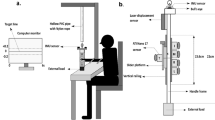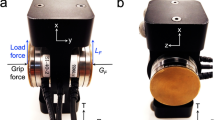Abstract
We investigated strategies of adjustments in kinetic and kinematic patterns, and in multi-digit synergies during quick vertical transport of an instrumented handle that collapsed when the grasping force exceeded a certain magnitude (quantified with a fragility index). The collapse threshold of the object was set using a novel electromagnetic device. Moving a fragile object is viewed as a task with two constraints on the grip force defined by the slipping and crushing thresholds. When moving more fragile objects, subjects decreased object peak acceleration, increased movement time, showed a drop in the safety margin (SM) (extra force over the slipping threshold), and showed a tendency toward violating the minimum-jerk criterion. Linear regression analysis of grip force against load force has shown tight coupling between the two with a decline in the coefficient of determination with increased fragility index. The SM was lower in bimanual tasks, compared to unimanual tasks, for both fragile and non-fragile objects. Two novel indices have been introduced and studied, the SM due to fragility and the drop–crush index. Both indices showed a decrease with increased object fragility. Changes in the drop–crush index showed that the subjects would rather crush the fragile objects as opposed to dropping them, possibly reflecting the particular experimental procedure. We did not find differences between the performance indices of the dominant and non-dominant hand thus failing to support the recently formulated dominance hypothesis. The synergies stabilizing grip force were quantified at two levels of an assumed two-level control hierarchy using co-variation indices between elemental variables across trials. There were strong synergies at the upper level of the hierarchy (the task is shared between the opposing groups of digits) that weakened with an increase in object fragility. At the lower level (action of an effector is shared among the four fingers), higher fragility led to higher synergy indices. Analysis of force variance showed that an increase in object fragility was accompanied by exploring a smaller range of equivalent combinations of elemental variables. The additional constraint imposed by high fragility facilitated synergies at the lower level of the hierarchy, while there was evidence for a trade-off between synergies at the two levels.











Similar content being viewed by others
References
Arbib MA, Iberall T, Lyons D (1985) Coordinated control programs for movements of the hand. Exp Brain Res Suppl 10:111–129
Boudreau MJ, Smith AM (2001) Activity in rostral motor cortex in response to predictable force-pulse perturbations in a precision grip task. J Neurophysiol 86:1079–1085
Budgeon MK, Latash ML, Zatsiorsky VM (2008) Digit force adjustments during finger addition/removal in multi-digit prehension. Exp Brain Res 189:345–359
Burstedt MK, Flanagan JR, Johansson RS (1997) Coordination of fingertip forces during human manipulation can emerge from independent neural networks controlling each engaged digit. Exp Brain Res 117:67–79
Burstedt MK, Flanagan JR, Johansson RS (1999) Control of grasp stability in humans under different frictional conditions during multidigit manipulation. J Neurophysiol 82:2393–2405
Cesari P, Newell KM (2000) Body-scaled transitions in human grip configurations. J Exp Psychol Hum Percept Perform 26:1657–1668
Feldman AG, Levin MF (2009) The equilibrium-point hypothesis—past, present and future. In: Sternad D (ed) Progress in motor control, a multidisciplinary perspective. Springer, New York, pp 699–726
Flanagan JR, Johansson RS (2002) Hand movements. In: Ramshandran VS (ed) Encyclopaedia of the human brain. Academic Press, San Diego, pp 399–414
Flanagan JR, Johansson RS (2009) Coding and use of tactile signals from the fingertips in object manipulation tasks. Nat Rev Neurosci 10:345–359
Flanagan JR, Tresilian J (1994) Grip-load force coupling: a general control strategy for transporting objects. J Exp Psychol Hum Percept Perform 20:944–957
Flanagan JR, Wing AM (1993) Modulation of grip force with load force during point-to-point arm movements. Exp Brain Res 95:131–143
Flanagan JR, Wing AM (1995) The stability of precision grip forces during cyclic arm movements with a hand-held load. Exp Brain Res 105:455–464
Flanagan JR, Tresilian J, Wing AM (1993) Coupling of grip force and load force during arm movements with grasped objects. Neurosci Lett 152:53–56
Flash T, Hogan N (1985) The coordination of arm movements: an experimentally confirmed mathematical model. J Neurosci 5:1688–1703
Friedman J, SKM V, Zatsiorsky VM, Latash ML (2009) The sources of two components of variance: an example of multifinger cyclic force production tasks at different frequencies. Exp Brain Res 196:263–277
Gao F, Latash ML, Zatsiorsky VM (2005) Control of finger force direction in the flexion-extension plane. Exp Brain Res 161:307–315
Gelfand IM, Latash ML (1998) On the problem of adequate language in motor control. Mot Control 2:306–313
Goodman SR, Shim JK, Zatsiorsky VM, Latash ML (2005) Motor variability within a multi-effector system: experimental and analytical studies of multi-finger production of quick force pulses. Exp Brain Res 163:75–85
Gorniak SL, Zatsiorsky VM, Latash ML (2007a) Hierarchies of synergies: an example of two-hand, multifinger tasks. Exp Brain Res 179:167–180
Gorniak SL, Zatsiorsky VM, Latash ML (2007b) Emerging and disappearing synergies in a hierarchically controlled system. Exp Brain Res 183:259–270
Gorniak SL, Zatsiorsky VM, Latash ML (2009a) Hierarchical control of prehension. I. Biomechanics. Exp Brain Res 193:615–631
Gorniak SL, Zatsiorsky VM, Latash ML (2009b) Hierarchical control of prehension. II. Multi-digit synergies. Exp Brain Res 194:1–15
Gorniak SL, Feldman AG, Latash ML (2009c) Joint coordination during bimanual transport of real and imaginary objects. Neurosci Lett 456:80–84
Hamill J, Selbie WS (2004) Three-dimensional kinematics. In: Robertson DGE et al (eds) Research methods in biomechanics. Human Kinetics, Champaign, IL, pp 35–52
Hogan N (1984) An organizing principle for a class of voluntary movements. J Neurosci 4:2745–2754
Jaric S, Corcos DM, Agarwal GC, Gottlieb GL (1993) Principles for learning single-joint movements. II. Generalizing a learned behavior. Exp Brain Res 94:514–521
Jaric S, Gottlieb GL, Latash ML, Corcos DM (1998) Changes in the symmetry of rapid movements: effects of velocity and viscosity. Exp Brain Res 120:52–60
Johansson RS (1996) Sensory control of dexterous manipulation in humans. In: Wing A, Haggard P, Flanagan R (eds) Hand and brain. Academic Press, San Diego, CA, pp 381–414
Johansson RS (1998) Sensory input and control of grip. Novartis Found Symp 218:45–59 (discussion 59–63)
Johansson RS (2002) Dynamic use of tactile afferent signals in control of dexterous manipulation. Adv Exp Med Biol 508:397–410
Johansson RS, Westling G (1984) Roles of glabrous skin receptors and sensorimotor memory in automatic control of precision grip when lifting rougher or more slippery objects. Exp Brain Res 56:550–564
Kang N, Shinohara M, Zatsiorsky VM, Latash ML (2004) Learning multi-finger synergies: an uncontrolled manifold analysis. Exp Brain Res 157:336–350
Kutz DF, Wölfel A, Timmann D, Kolb FP (2009) Dynamic torque during a precision grip task comparable to picking a raspberry. J Neurosci Methods 177:80–85
Latash ML, Zatsiorsky VM (2009) Multi-finger prehension: control of a redundant mechanical system. Adv Exp Med Biol 629:597–618
Latash ML, Scholz JF, Danion F, Schöner G (2002a) Finger coordination during discrete and oscillatory force production tasks. Exp Brain Res 146:419–432
Latash ML, Scholz JP, Schöner G (2002b) Motor control strategies revealed in the structure of motor variability. Exerc Sport Sci Rev 30:26–31
Latash ML, Scholz JP, Schöner G (2007) Toward a new theory of motor synergies. Mot Control 11:275–307
Latash ML, Gorniak SL, Zatsiorsky VM (2008) Hierarchies of synergies in human movements. Kinesiology 40:29–38
Newell KM, Carlton LG (1988) Force variability in isometric responses. J Exp Psychol Hum Percept Perform 14:37–44
Olafsdottir H, Yoshida N, Zatsiorsky VM, Latash ML (2007) Elderly show decreased adjustments of motor synergies in preparation to action. Clin Biomech (Bristol, Avon) 22:44–51
Oldfield RC (1971) The assessment and analysis of handedness: the Edinburgh inventory. Neuropsychologia 9:97–113
Pataky TC, Latash ML, Zatsiorsky VM (2004) Prehension synergies during nonvertical grasping. I. Experimental observations. Biol Cybern 91:148–158
Pilon JF, De Serres SJ, Feldman AG (2007) Threshold position control of arm movement with anticipatory increase in grip force. Exp Brain Res 181:49–67
Sainburg RL (2002) Evidence for a dynamic-dominance hypothesis of handedness. Exp Brain Res 142:241–258
Sainburg RL (2005) Handedness: differential specialization for control of trajectory and position. Exerc Sport Sci Rev 33:206–213
Savescu AV, Latash ML, Zatsiorsky VM (2008) A technique to determine friction at the fingertips. J Appl Biomech 24:43–50
Shim JK, Latash ML, Zatsiorsky VM (2003) Prehension synergies: trial-to-trial variability and hierarchical organization of stable performance. Exp Brain Res 152:173–184
Shim JK, Latash ML, Zatsiorsky VM (2005a) Prehension synergies in three dimensions. J Neurophysiol 93:766–776
Shim JK, Olafsdottir H, Zatsiorsky VM, Latash ML (2005b) The emergence and disappearance of multi-digit synergies during force-production tasks. Exp Brain Res 164:260–270
Slifkin AB, Newell KM (2000) Variability and noise in continuous force production. J Mot Behav 32:141–150
Smeets JB, Brenner E (1999) A new view on grasping. Mot Control 3:237–271
Teulings HL, Contreras-Vidal JL, Stelmach GE, Alder CH (1997) Parkinsonism reduces coordination of fingers, wrist, and arm in fine motor control. Exp Neurol 146:159–170
Wang J, Sainburg RL (2007) The dominant and nondominant arms are specialized for stabilizing different features of task performance. Exp Brain Res 178:570–656
Wiegner AW, Wierzbicka MM (1992) Kinematic models of human elbow flexion movements: quantitative analysis. Exp Brain Res 88:665–673
Wing AM, Flanagan JR, Richardson J (1997) Anticipatory postural adjustments in stance and grip. Exp Brain Res 116:122–130
Winges SA, Eonta SE, Soechting JF, Flanders M (2009) Effects of object compliance on three-digit grasping. J Neurophysiol 101:2447–2458
Zatsiorsky VM, Latash ML (2008) Multifinger prehension: an overview. J Mot Behav 40:446–475
Zatsiorsky VM (1998) Kinematics of human motion. Human Kinetics, Champaign, IL
Zatsiorsky VM, Gao F, Latash ML (2003) Finger force vectors in multi-finger prehension. J Biomech 36:1745–1749
Zatsiorsky VM, Gao F, Latash ML (2005) Motor control goes beyond physics: differential effects of gravity and inertia on finger forces during manipulation of hand-held objects. Exp Brain Res 162:300–308
Zatsiorsky VM, Gao F, Latash ML (2006) Prehension stability: experiments with expanding and contracting handle. J Neurophysiol 95:2513–2529
Zhang W, Olafsdottir HB, Zatsiorsky VM, Latash ML (2009) Mechanical analysis and hierarchies of multidigit synergies during accurate object rotation. Mot Control 13:251–279
Acknowledgments
The study was in part supported by NIH grants AG-018751, NS-035032, and AR-048563. We would like to thank Jason Friedman and Jim Metzler for their assistance in data collection as well as to thank PCB Piezotronics (Depew, NY, USA) for donating the accelerometer used in this study.
Author information
Authors and Affiliations
Corresponding author
Rights and permissions
About this article
Cite this article
Gorniak, S.L., Zatsiorsky, V.M. & Latash, M.L. Manipulation of a fragile object. Exp Brain Res 202, 413–430 (2010). https://doi.org/10.1007/s00221-009-2148-z
Received:
Accepted:
Published:
Issue Date:
DOI: https://doi.org/10.1007/s00221-009-2148-z




